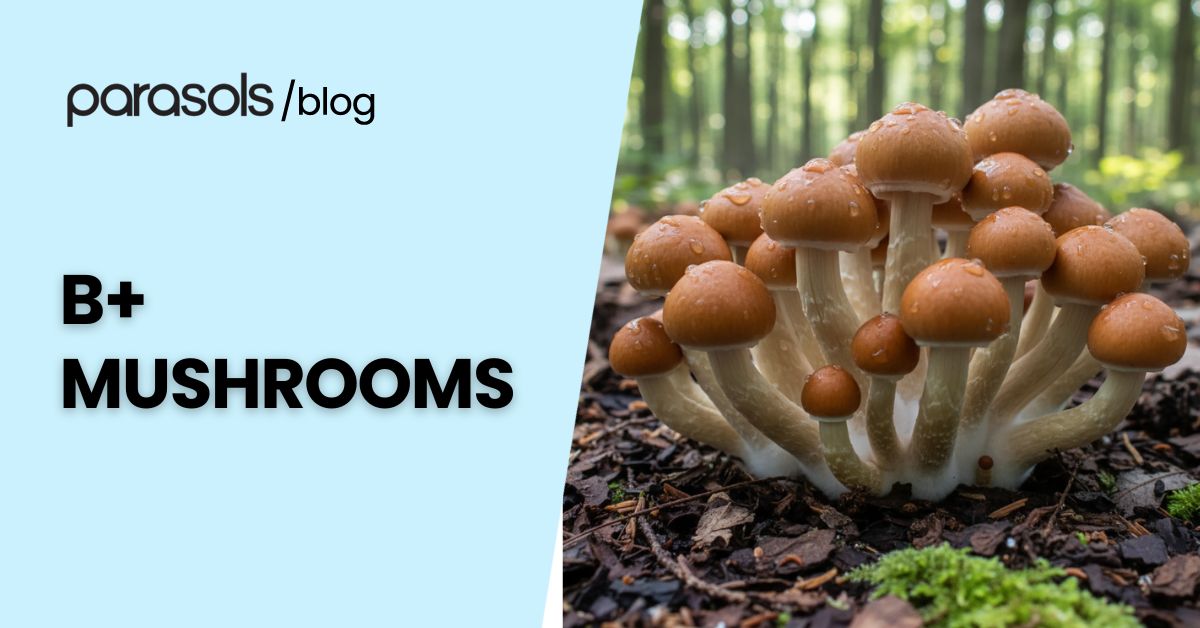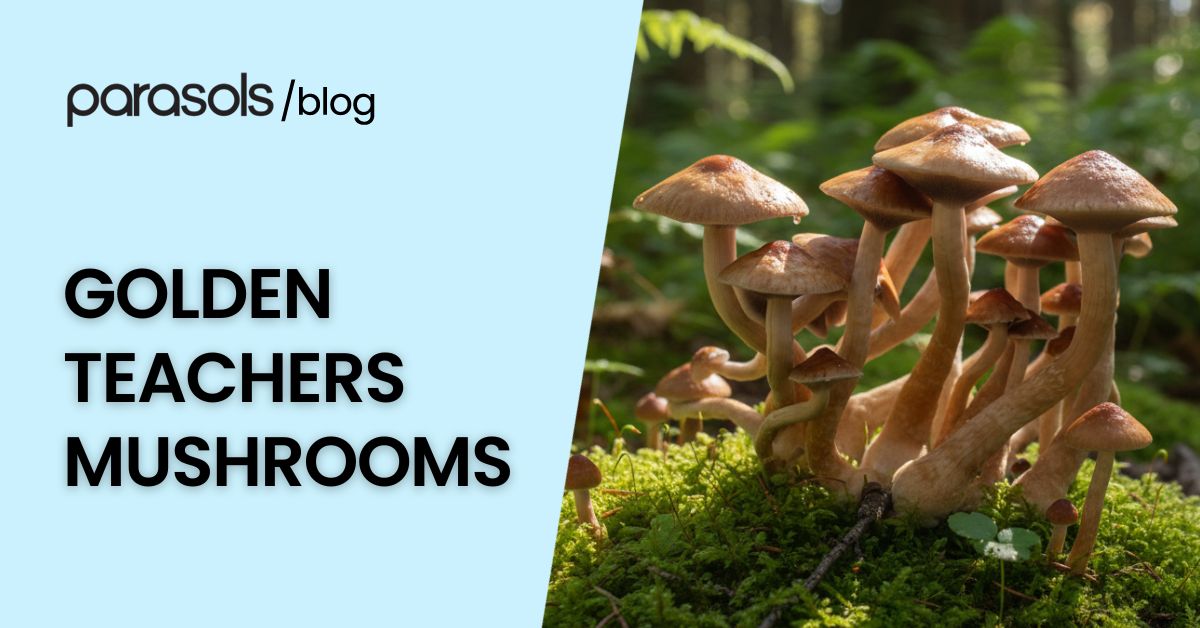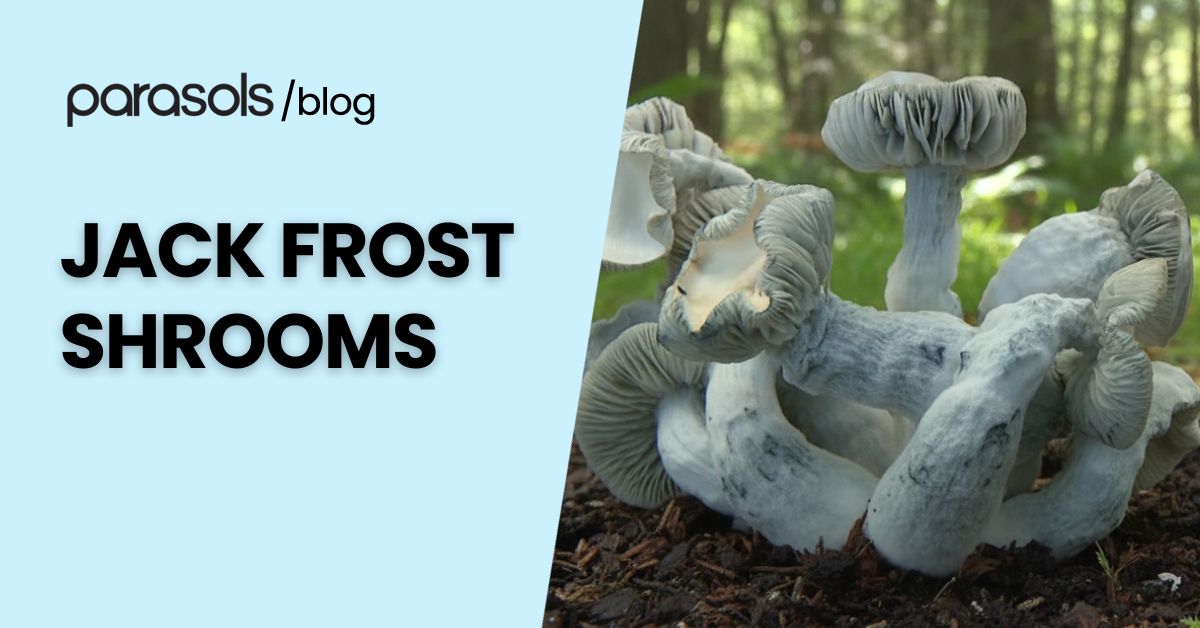B+ mushrooms often spark curiosity because of their gentle yet uplifting effects. People describe them as approachable, making them a popular starting point for those learning psilocybin containing mushrooms.
Whether you’ve heard stories from a friend, stumbled across them while learning about medicinal mushrooms, or are simply curious about how different cubensis strains vary, the B+ mushroom strain has a reputation for warmth, clarity, and connection.
Key Takeaways
- B+ mushrooms are a popular psilocybe cubensis strain known for being approachable
- Recognized for large fruiting bodies and adaptable cultivation
- Effects are gentle, uplifting, and balanced compared to stronger strains
- Often associated with emotional warmth, introspection, and connection
- Favored by both beginners and experienced users for reliability and resilience
What are B+ Mushrooms?

B+ mushrooms are a well-known strain of psilocybe cubensis, a species of magic mushrooms recognized for their wide use and approachable nature. This strain is often praised for its thick stems, large fruiting bodies, and reliable growth from psilocybe cubensis spores, making it popular among cultivators and enthusiasts alike.
People value B+ not only for its resilience in different cultivation methods using mushroom spores or spore syringes, but also for the balanced experiences it tends to produce—gentle visuals, emotional warmth, and a sense of connection that makes it welcoming for beginners while still appreciated by seasoned explorers of hallucinogenic mushrooms and other psychoactive drugs.
B+ Mushroom Traits
B+ mushrooms stand out in the world of psilocybe cubensis strains because of their consistency, appearance, and the experiences they inspire. Growers and users alike recognize this strain for qualities that make it both accessible and rewarding, even when compared to thai cubensis strains or other popular hallucinogenic mushrooms.
Appearance
B+ mushrooms are known for their thick stems and large, golden-brown caps that often develop into broad, eye-catching fruiting bodies. Their size and sturdiness make them one of the more visually striking cubensis strains frequently studied in mushroom matrices and microscopy research.
Growth and Cultivation
This strain adapts well to different cultivation methods, thriving in environments like cow dung, sugar cane mulch, or grain-based substrates. Many growers choose B+ because of its resilience and faster growth compared to some other strains, especially when starting from mushroom spores or spore syringes, making it easier to cultivate even with less experience.
Potency and Experience
While not considered the most intense among psilocybin containing mushrooms, B+ mushrooms offer a reliable and balanced effect. Users often describe the experience as warm, positive, and clear, with gentle visuals and a welcoming sense of euphoria. This balance makes them especially popular for those new to psychedelic mushrooms or curious about how different psychoactive drugs compare.
Popularity in the Community
Thanks to their adaptability, approachable effects, and consistent results, B+ mushrooms remain one of the most sought-after cubensis strains worldwide. They’re often included in discussions about multiple mushrooms used for psilocybin assisted therapy and are valued as much as any carefully prepared mushroom extract.
Benefits of B+ Mushrooms
B+ mushrooms have gained popularity not just for how easy they are to grow, but also for the positive ways people say they can influence mood, mindset, and perspective. Many users highlight benefits that go beyond the immediate psychedelic experience.
- Emotional uplift – Many describe feelings of warmth, joy, and connection that help ease stress and encourage a more positive outlook.
- Gentle psychedelic experience – Compared to stronger cubensis strains like penis envy or blue meanie, B+ tends to offer smoother visuals and manageable intensity, making it approachable for beginners.
- Support for introspection – Users often report that B+ mushrooms help them reflect on life with greater clarity, encouraging personal insights and new perspectives.
- Community connection – Shared experiences with B+ mushrooms often foster a sense of bonding, making them popular in group settings or ceremonial use.
- Resilient cultivation – Beyond the personal effects, growers value the strain for its adaptability and faster growth, leading to more consistent harvests of intact mushrooms.
How to Effectively Use the B+ Mushroom Strain
Using B+ mushrooms effectively comes down to preparation, intention, and understanding how this strain works in the human body. Whether for personal growth, creativity, or relaxation, a thoughtful approach can make the experience more meaningful.
- Start with the right setting – Choose a comfortable, safe environment where you feel relaxed. Setting plays a big role in shaping how psilocybin and psilocin content are experienced.
- Begin with a moderate dose – Since B+ mushrooms are known for gentle effects, beginners often find it best to start with smaller amounts before examining higher concentration levels.
- Mind your mindset – Go into the experience with openness and curiosity. A calm, positive outlook helps reduce anxiety and enhances the potential for mystical experiences.
- Stay hydrated and nourished – Light meals before use and plenty of water during the journey can help the human body process psychoactive compounds more smoothly.
- Respect integration – After the effects fade, take time to reflect on insights gained. Journaling, meditation, or talking with a trusted friend can deepen the benefits of psilocybin assisted therapy.
Final Thoughts

B+ mushrooms have earned their reputation as one of the most inviting psilocybe cubensis strains. With sturdy fruiting bodies, adaptable cultivation methods, and a gentle, uplifting experience, they continue to attract both growers and explorers alike.
This strain blends resilience with approachability, making it a favorite for those who want clarity, warmth, and connection in their journey. If you’re curious to experience it yourself, determine where to get B+ mushrooms today. Parasols offer high quality mushroom gummies like our pineapple non detect shroom gummies.
Frequently Asked Questions
Are B+ mushrooms stronger than other cubensis strains?
B+ mushrooms are considered moderately potent compared to other cubensis strains. While not as strong as penis envy or blue meanie, they still contain psilocybin and psilocin in levels that can produce meaningful psychedelic effects. Many users appreciate their smoother intensity, which makes them more approachable for those who prefer a balanced experience rather than overwhelming visuals.
How long do the effects of B+ mushrooms usually last?
The effects of B+ mushrooms typically last between 4 to 6 hours, depending on factors like dosage, individual metabolism, and whether the mushrooms are consumed fresh or dried. The peak usually occurs within the first two hours, with aftereffects of calmness and reflection that can linger for a few more hours.
Can you grow B+ mushrooms at home?
Yes, many cultivators choose B+ mushrooms because they’re adaptable and relatively easy to grow. With proper cultivation methods—using substrates such as cow dung, sugar cane mulch, or grain—they tend to produce large, healthy fruiting bodies. Beginners often find success with this strain thanks to its resilience and faster growth.
Are there any risks with using B+ mushrooms?
Like all psilocybin containing mushrooms, B+ mushrooms should be used responsibly. Common risks include nausea, anxiety, or overwhelming feelings if taken in high doses or in stressful settings. Following safety protocols, starting with a moderate dose, and ensuring a supportive environment can reduce these risks.
Do B+ mushrooms have medicinal potential?
Research on psilocybin assisted therapy suggests that psilocybin mushrooms, including B+, may hold promise for conditions such as treatment resistant depression and anxiety. While further research is still needed, early studies point toward their potential in therapeutic settings when used under professional guidance.
How do B+ mushrooms compare to medicinal mushrooms like reishi or lion’s mane?
Medicinal mushrooms such as reishi, lion’s mane, or chaga are non-psychoactive and valued for their immune-supporting and cognitive benefits. In contrast, B+ mushrooms belong to the genus psilocybe and are prized for their psychoactive compounds, which can induce mystical experiences and emotional healing. Each serves a different purpose depending on a person’s wellness goals.
What are mushroom matrices?
Mushroom matrices refer to structured groupings or data sets used to compare different mushroom strains, compounds, or growth outcomes. They are often used in scientific or cultivation contexts to track variables like potency, yield, or alkaloid content. Several mushroom matrices (0/2–5) may be analyzed depending on the depth of study.
What does “average content differences” mean in mushroom studies?
Average content differences describe the measurable variations in compounds like psilocybin or psilocin across different mushroom samples or strains. Researchers sometimes quantify these differences (0/2–5) to understand potency ranges, consistency in cultivation, or effects between batches.
What is the Psilocybe genus?
The genus Psilocybe contains a wide range of mushrooms known for producing psilocybin and psilocin, the primary psychoactive compounds. Well-known species include Psilocybe cubensis, Psilocybe semilanceata, and Psilocybe azurescens. Studies on this genus (0/1–2) are key to understanding their cultural, therapeutic, and ecological roles.
How is clinical potency of mushrooms determined?
Clinical potency determination involves testing mushrooms for their concentration of active compounds, usually psilocybin and psilocin, and correlating those levels with observed psychoactive or therapeutic effects. This often includes quantitative lab analysis (0/2–5) and controlled human studies.
What is liquid culture in mushroom cultivation?
Liquid culture is a cultivation technique where mushroom mycelium is grown in a nutrient-rich liquid medium. This method allows for rapid expansion and easier inoculation of substrates compared to spores. Depending on goals, cultivators may maintain multiple liquid cultures (0/4–20) to preserve genetics or scale production.
What is quantitative analysis in mushroom research?
Quantitative analysis measures the precise concentration of active compounds like psilocybin, psilocin, baeocystin, or norbaeocystin within mushroom samples. Scientists use methods like HPLC or mass spectrometry for accuracy. Such analysis (0/1–4) is vital for consistency, safety, and clinical research.



Leave a comment
All comments are moderated before being published.
This site is protected by hCaptcha and the hCaptcha Privacy Policy and Terms of Service apply.